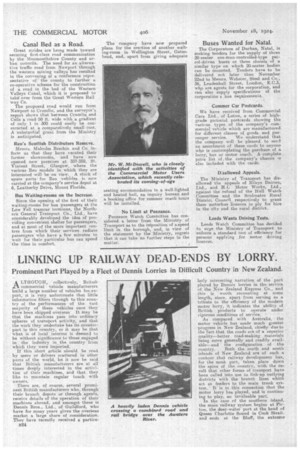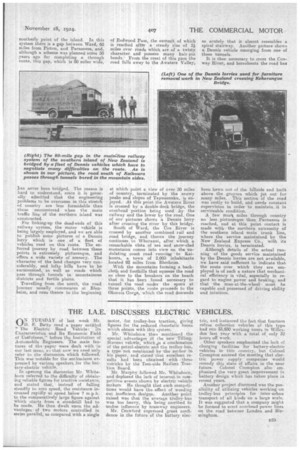LINKING UP RAILWAY DEAD-ENDS BY LORRY.
Page 8

Page 9

If you've noticed an error in this article please click here to report it so we can fix it.
Prominent Part Played by a Fleet of Dennis Lorries in Difficult Country in New Zealand.
A LTHOUGH, collectively, British commercial vehicle manufacturers build a large number of vehicles foe, export, it is very unfortunate that little information filters through to this country of the performances of the vast majority of these vehicles once they have been shipped overseas' It may he that the machines pass into ordinary spheres of transport activity, and that the work they undertake has its counterpart in this country, or it may be that what is of local interest is deemed to be without significance to those engaged in the industry in the country from which they Were imported. If this short article should be read, by users or drivers scattered in other parts of the world, let it now be said that British manufacturers are at all times deeply interested in the activities of their machines, and that, they like to maintain regular touch with owners. There are, of course, several prominent British manufacturers who, through their branch depots or through agents, receive details of the operation of their machines abroad, and amongst these is Dennis Bros., Ltd., of Guildford, who have for many years given the overseas market a large share of consideration. They have recently received a particu
B24
larly interesting narration of the part played by Dennis lorries in the service of the New Zealand Express Go., and this is worth recounting at some length, since, apart from serving as a tribute to the efficiency of the modern motor lorry, it indicates the ability of British products to operate under rigorous conditions of service. As compared with Australia, the motor vehicle has made much greater progress in New Zealand, chieflydue to the fact that the roads are of a superior quality—better road-making materials being more generally and readily available—and the configuration of the country. Both the north and south islands of New Zealand are of such a contour that railway development has, for the most part, taken place down the spine of the country, with the result that other forms of transport have been called into use to link-up outlying districts with the branch lines which act as feeders to the main trunk system. It is in this connection that the motor lorry has played, and is continuing to play, an invaluable part.
In the case of the southern island, the main railway system begins at Picton, the deep-water port at the head of Queen Charlotte Sound in Cook Strait. and ends at the Bluff, the extreme southerly point of the island. In this system there is a gap between Ward, 60 miles from Picton, and Parnassua, and, although a scheme was planned some 50 years ago for completing a through route, this gap, which is 80 miles wide, has never been bridged. The reason is hard to understand, since it is generally admitted that the engineering Problems to be overcome in this stretch of country are less formidable than those encountered when the main traffic line of the northern island was constructed.
For linking-up the dead-ends of this
• railway system, the motor vehicle is being largely employed, and we are able to publish some pictures of a Dennis lorry which is one of a fleet of vehicles used on this route. The enforced journey by road between these points is extremely picturesque, and offers a wide variety of scenery.. The character of the land changes very considerably, and lofty hills have to be surmounted, as well as roads which -Pass through tunnels in mountainous districts and fertile plains.
Travelling from the north, the road journey usually cOmmences at Blenheim, and runs thence to the beginning
of Redwood Pass, the summit of which is reached after .a steady rise of 21 miles over roads which are of a twisty character and possess many hair pin bends.' From the crest of this pass the road falls away to the Awatere Valley,
at which point a view of over 30 miles of country, terminated by the snowy peaks and slopes of Tapitaenuku, is enjoyed. At this point the Awatere River is crossed by a double-deck bridge, the overhead portion being used by • the railway and the lower by the road. One of our pictures shows a Dennis lorry after crossing the river by this bridge. South of Ward, the 'ere River is crossed by another combined rail and road bridge, and thence the journey Continues to Wharanui, after, which a remarkable vista of sea and snow-clad mountains comes into view on the undulating coast road running to Kaikoura, a town of 2,000 inhabitants located 92 miles from Blenheim.
With the mountains forming a backcloth and foothills that squeeze the road so close to the breakers on the beach that it has been found necessary to tunnel the road under the spurs at three points, the route proceeds to the Okoraia Gorge, which the road descends so acutely that it almost resembles a spiral stairway. Another picture shows a Dennis vehicle emerging from one of these tunnels.
It is thee necessary to cross the Conway River, and hereabouts the road has been hewn out of the hillside and built above the groynes which jut out for many miles. This section of the road was costly to build, and needs constant supervision in order to maintain, it in serviceable condition.
A few motet miles through country no less picturesque than Parnassus is reached, and at this point contact is made with the northern extremity Of the southern island main trunk line, where the service maintained by the New Zealand Express Co., with its Dennis lorries, is terminated.
Although details of the actual running of the goods service maintained by the Dennis lorries are not available, we have said sufficient to indicate that the route over which they are employed is of such a nature that mechanical efficiency is vital, especially in regard to engine power and braking, and that the man-at-the-wheel must be capable and possessed of drivin.g ability and intuition.
































